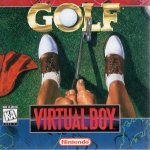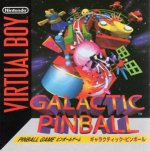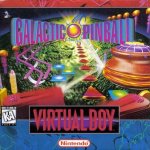Website Temporary Closed
Nintendo Virtual Boy
The The Nintendo Virtual Boy is a console that, using a twin eyeglass-style projector, could display games in "true 3-D" (though monochromatic, in this case black and red). It developed from an emerging cultural interest in virtual reality brought on by movies such as The Lawnmower Man and a number of popular arcade games. Released on August 14, 1995 in the USA and July 21, 1995 in Japan - at a price of around $180 USD - the Virtual Boy was regarded as little more than a novelty, and Nintendo discontinued it the following year.
The console was designed by Gunpei Yokoi, inventor of the Game & Watch and Game Boy handhelds. While compact and seemingly portable, Virtual Boy was not intended to replace the Game Boy in Nintendo's product line, as use of the system requires a steady surface, and completely blocks the player's peripheral vision.
Hype surrounding the device before its release included public musings by Nintendo that the device might resemble a gun set vertical, projecting a 3D image in the air above it. The actual device was considered a disappointment compared to this description when it arrived.
[collapse collapsed title=read more...]
At the time, Nintendo was considered nearly invincible in the videogame market with the massive success of the NES, SNES, and Game Boy and its ability to hold arch-rival Sega at bay as the Nintendo 64 was being developed. While Nintendo's decline of dominance was mostly due to the emerging Sony PlayStation console, some market analysts and video game historians point to the release and failure of the Virtual Boy as the "beginning of the end."
The Virtual Boy was a flop in the marketplace, for several reasons:-
To fill in for the long delay in the development of the Nintendo 64, it was pushed to market before it was ready. Not only was it rushed out the door, but the public was unwilling to spend so much money on what they saw as a stopgap videogame system, especially knowing the Nintendo 64 was coming shortly.
It was marketed as a portable system, but it was not as portable as gamers thought it should be. Due to its size and weight, the Virtual Boy was nearly impossible to use while in motion, and doing so could cause damage to the unit.
The console's box and manual warned that the display could cause eyestrain and eye problems, especially for those under 7 years of age. Despite having been added primarily for liability reasons, the warnings frightened away potential buyers. Some that did buy it suffered from headaches from short times spent playing games on the machine.
Many believed there was a poor selection of games available at launch, and very few software developers wanted to invest time and money in such a new, unproven gaming system. This led to a circular supply-and-demand problem and resulted in a system with few games available. In total only 22 titles were available between the North American and Japanese markets. Additionally, there were few plans for any flagship titles (such as Metroid, Zelda, or Star Fox) or popular third party titles (such as Final Fantasy or other Squaresoft games) to be released. Other game problems were related to the format of the console itself, which did not seem especially suited for certain types of games, giving players the impression that it was a rather limited system.
The base of the system could not be adjusted vertically. This meant that most players had to lean over to play games resulting in back-pains after a short time of play. The base was also somewhat flimsy and replacement parts were not very common. If the base broke, a way of continuing play was to view set the console on its back and view downward. This would frequently result in a mark being present on the player's forehead.
Due to the nature of the Virtual Boy system, the system was not only single player, but other players could not watch, taking away the social aspect of gaming. While Mario's Tennis could be played between two Virtual Boy units, the system never achieved the popularity necessary for most to use this feature.
The system does not have a full 384 x 224 array of LEDs as a display. It uses a pair of 1 x 224 linear arrays (one per eye) and rapidly scans the array across the eye's field of view using curved oscillating mirrors. These mirrors vibrate back and forth at very high speed (they are what produce the mechanical humming noise from inside the unit) and can be damaged if the Virtual Boy is hit, knocked over, or used while in rough motion (such as in a car). A full-size display, while mechanically simpler, would have increased the Virtual Boy's physical size and unit cost to the point where the system would become uneconomical. Every Virtual Boy game has the option to pause automatically every 15-30 minutes to remind the player to take a break, to prevent undue eye strain and possible headaches
A full colour Virtual Boy was impossible to release in 1995, due to the fact that high-efficiency indium gallium nitride (InGaN) blue and green LEDs only became available from Nichia in 1996. While blue LEDs did exist before then, they were extremely inefficient, resulting in very low brightness. Furthermore, the cost of blue and green LEDs was prohibitive, and the system was already quite expensive. The Virtual Boy, which uses an oscillating mirror to transform a 1-D line of dots into a 2-D field of dots, requires high-performance LEDs in order to function properly. Because each pixel is only in use for a tiny fraction of a second (384 pixels wide, 50.2 Hz scan rate = approximately 52 µS per scanline), high peak brightness is needed to make the virtual display bright and be comfortable for the user to view. The two-screen system demanded a fast refresh rate, unlike the Game Boy with its blurry motion, so LCD was not an option. Without the technology of blue and green LEDs or LCD, the Virtual Boy was limited to a monochrome red LED display.
Because of its failure in the Japanese, and in the American market, the console was never released in Australia or Europe. This contributed to a supply-and-demand problem (undersupply) for Nintendo products (especially Super Famicom and SNES games) in the middle of the 1990s that existed mainly due to continuous delays of the Nintendo 64. Nevertheless, the system continues to maintain a cult following, and some of the games fetch over $1000US.
[/collapse]
- « first
- ‹ previous
- 1
- 2
- 3
- 4
- HOME


- PRODUCTS

- 3DO
- Amiga CD32
- Amstrad GX4000
- Atari 2600
- Atari 7800
- Atari Jaguar
- Atari Jaguar CD
- Atari Lynx
- Bandai Wonderswan
- Coleco
- Colecovision
- Famicom
- Famicom Disk System
- Grandstand
- JAMMA
- Mattel Intellivision
- MB
- Microsoft Xbox
- MSX
- Neo Geo AES
- Neo Geo CD
- Neo Geo MVS
- Neo Geo Pocket
- Nintendo 64
- Nintendo Game and Watch
- Nintendo Gameboy
- Nintendo Gameboy Advance
- Nintendo Gameboy Colour
- Nintendo Gamecube
- Nintendo NES
- Nintendo Virtual Boy
- PC Engine
- PC Engine CD
- Philips CDI
- Sega 32X
- Sega Dreamcast
- Sega Game Gear
- Sega Genesis
- Sega Master System
- Sega Mega CD
- Sega Megadrive
- Sega Nomad
- Sega Saturn
- Sony Playstation
- Sony Playstation 2
- Super Famicom
- Super Nintendo
- Texas Instruments
- Tiger Game Com
- Tomy
- Vectrex
- Japanese Video Game Imports
-

- MODIFICATIONS

- Switchless Modification
- Modification Sega 32X
- Modification Sega Dreamcast
- Modification Sega Megadrive
- Modification Neo Geo AES
- Modification Neo Geo CD
- Modification Nintendo NES
- Modification Sega Master System
- Modification Sega Mega-CD
- Modification Sega Nomad
- Modification Sega Saturn
- Modification Super Nintendo
-

- TECHNICAL INFO


- NEWS


- ABOUT US


- MEMBERS


- CONTACT US


Log on
x
Just In!





 Save time
Save time